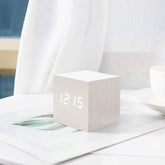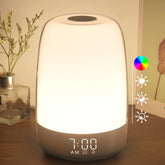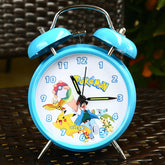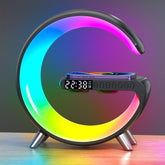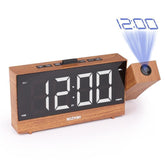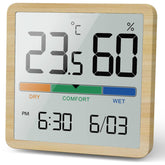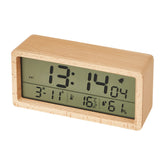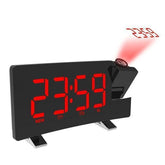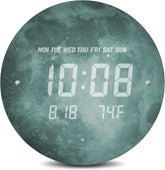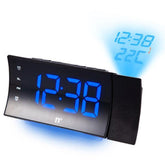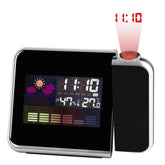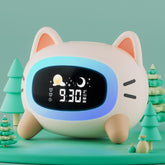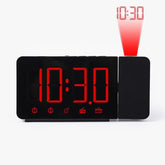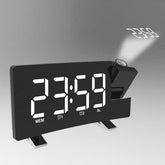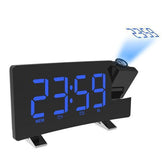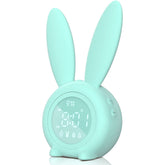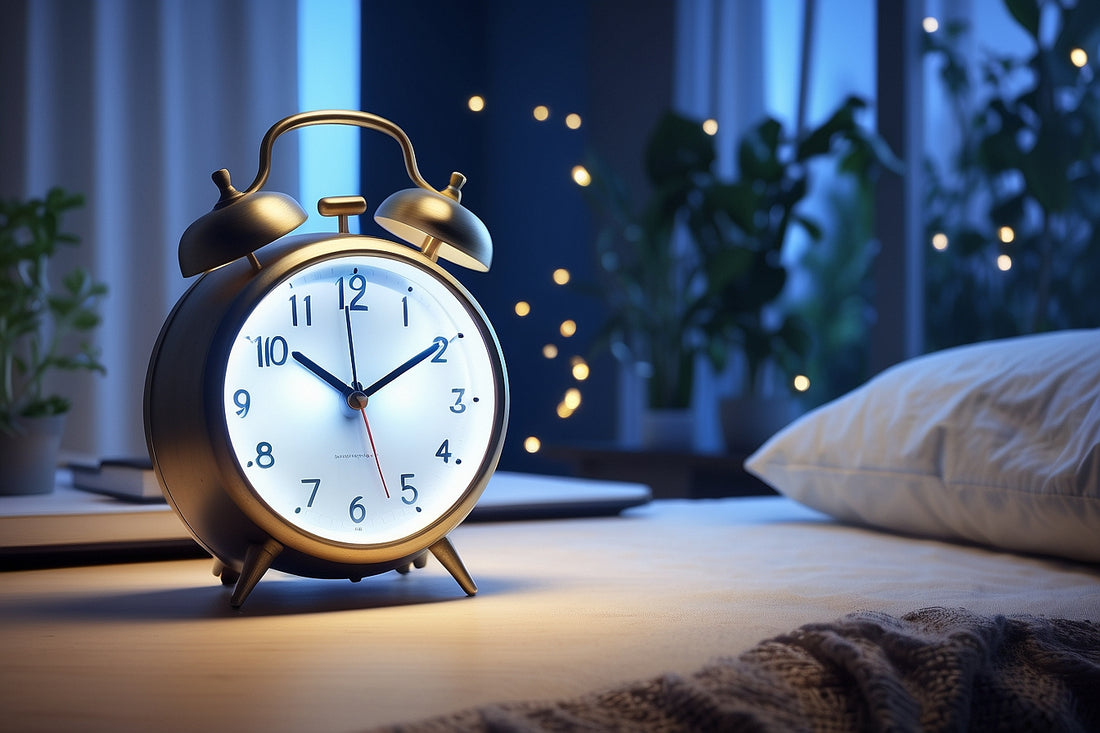What Color Alarm Clock is best for Sleeping?
In the quest for a restful night's sleep, the color of your alarm clock might not be the first factor you consider. However, the hues that surround us, particularly those we wake up to, can have a profound impact on our sleep quality and overall well-being. 'Soothing Slumber: Discovering the Best Alarm Clock Colors for a Restful Sleep' delves into the relationship between color, sleep, and how the right alarm clock can contribute to a serene sleep environment. From the psychology of colors to the innovative features of modern alarm clocks, this article explores how to harmonize your sleep sanctuary for the ultimate soothing slumber.
Key Takeaways
-
The psychology of color plays a significant role in sleep quality, with certain colors promoting relaxation and others potentially causing stimulation.
-
Cool tones like blues and greens are generally considered to be calming and conducive to sleep, while warm colors can have varying effects on sleep hygiene.
-
The features of an alarm clock, including color, brightness, and sound, should be chosen to support non-disruptive wake-up calls, enhancing sleep hygiene.
-
Incorporating the right shades of alarm clock colors, such as tranquil blues or rejuvenating greens, can contribute to a peaceful night's rest and a pleasant wake-up experience.
-
Beyond color, factors such as room temperature, technology use, and alarm clock features like smart adaptability and gradual lighting play a crucial role in achieving restful sleep.
The Psychology of Color in Sleep Environments
Understanding Color Theory
Let's break down color theory into bite-sized pieces. Think of it as the study of how colors make us feel and behave. It's like a secret language where every shade has its own vibe. For example, some colors can pump you up, while others can chill you out. It's all about the emotional reactions they stir up inside us.
When we talk about colors, we often mention the color wheel. It's a handy tool that shows us how different colors relate to each other. Colors sitting side by side are like best buddies; they're called analogous colors and they get along smoothly. Then, there are the opposites, or complementary colors, which really pop when they're together.
Here's a quick tip: if you want a calm and cozy room, go for colors that are close on the color wheel. They create a peaceful vibe. But if you're after some drama and excitement, pick colors that are across from each other. They'll bring in that wow factor.
-
Cool Colors: Blues, greens, and purples. They're like a breath of fresh air, making you feel calm and collected.
-
Warm Colors: Reds, oranges, and yellows. These are your go-to for energy and warmth, but they can be too intense for sleep if you're not careful.
Remember, the colors around you can influence your mood and even your sleep. So, choosing the right ones for your bedroom, especially your alarm clock, can make a big difference in how restful your nights are.
How Colors Influence Sleep Quality
Ever wondered why some colors make you feel calm and others keep you wide awake? It's all about how colors mess with your brain and body. Cool colors, like blues and greens, are like a chill pill for your eyes. They tell your brain to relax and get ready for some zzz's. On the flip side, loud colors like bright reds and oranges can make your brain think it's go-time, not slow-time.
Here's the deal: colors can either be a snooze buddy or a sleep stealer. For example, a soft blue might soothe you into dreamland, while a harsh red could leave you tossing and turning. It's all about finding the right shade that whispers, 'sleep tight,' to you.
Remember, your bedroom isn't just a place to crash – it's your personal sleep haven. So, picking the right colors for your alarm clock and walls can make a big difference. Think of it as setting the mood for a great night's sleep. And who doesn't want that?
Exploring the Spectrum: Which Colors Promote Better Sleep?

The Calming Effect of Cool Tones
Ever noticed how a walk by the ocean or a stroll through a forest leaves you feeling refreshed? That's the power of cool tones at work. Colors like blues and greens have a natural ability to calm our minds and can be just as effective in our bedrooms. When it comes to alarm clocks, choosing one with a cool-colored display can help maintain that serene atmosphere, even when it's time to wake up.
Blue, for instance, is often linked to feelings of tranquility and serenity. It's no wonder many people prefer a soft blue glow from their alarm clock. It's like having a piece of the sky right by your bedside, gently nudging you awake. Here's a quick rundown of why cool tones are sleep's best friend:
-
Blue light is known for its calming effect and can reduce stress.
-
Green hues remind us of nature, helping to create a restful environment.
-
Cool colors can lower heart rate and blood pressure, which promotes better sleep.
Remember, the goal is to create a sleep sanctuary that feels like a personal retreat. The right alarm clock color is just one piece of that puzzle.
Warm Colors and Their Impact on Sleep
When we think about warm colors, images of fiery reds, sunny yellows, and cozy oranges often come to mind. These hues have a reputation for being lively and energetic, but can they also play a role in helping us wind down at night? Surprisingly, certain warm colors might just have a place in the bedroom, especially when we're talking about alarm clocks.
For instance, a soft orange glow can mimic the calming effect of a sunset, signaling to our bodies that it's time to relax. However, it's all about finding the right shade and intensity. A gentle, muted orange can be soothing, while a bright, neon orange might be too stimulating when you're trying to catch some Z's.
Here's a quick rundown of how different warm tones can affect our sleep readiness:
-
Soft Orange: Encourages relaxation, reminiscent of a sunset.
-
Muted Red: Can be comforting in the right context, but use sparingly.
-
Pale Yellow: Offers a sense of warmth and coziness without overstimulation.
Tip: When choosing an alarm clock, consider one with adjustable color settings so you can find the perfect warm tone for your sleep sanctuary.
The Role of Alarm Clocks in Sleep Hygiene
Choosing the Right Alarm Clock Features
When it comes to picking an alarm clock that won't jolt you awake, it's all about the features. Think of your alarm clock as a friendly nudge rather than a drill sergeant's shout. Here's the scoop on what to look for:
-
Snooze Function: We all love that extra few minutes of sleep. A snooze button is a must for those mornings when you're just not ready to get up.
-
Adjustable Volume: Start your day on the right note with an alarm that doesn't scare you awake. Look for one that lets you turn down the decibels.
-
Multiple Alarms: Some days you need a backup plan. Having the option to set more than one alarm can be a lifesaver.
-
Gentle Wake-Up Features: Alarms that mimic sunrise or play soft nature sounds can make waking up a lot less stressful.
Tip: Don't forget to consider the alarm clock's ease of use. You don't want to be fumbling around in the dark trying to hit snooze or turn off the alarm.
The Importance of Non-Disruptive Wake-Up Calls
Imagine waking up feeling refreshed, not jolted out of your dreams by a blaring alarm. That's the magic of a non-disruptive wake-up call. It's all about easing you into your day. Think of it as a gentle nudge rather than a loud shout.
Alarm clocks have come a long way from the dreaded buzz or beep. Now, they can simulate sunrise, play soft nature sounds, or even vibrate gently. Here's the deal: the less shocking your wake-up call, the better you'll feel.
-
Gentle sounds: Birds chirping or soft music can be a pleasant alternative to harsh tones.
-
Vibrations: For those who need a silent wake-up, a vibrating alarm can be placed under a pillow.
-
Light: Gradual light that mimics the sunrise can help your body wake up naturally.
Remember, the goal is to wake up feeling good. So, choosing the right alarm features can make all the difference. It's not just about the color of your alarm clock; it's how it wakes you up that counts.
Top Alarm Clock Colors for a Peaceful Night's Rest

Shades of Blue: Tranquility and Serenity
Ever wondered why you feel so calm looking at a clear blue sky? It turns out, the color blue has a special power to relax our minds and help us wind down. When it comes to sleep, this color is a real MVP. A splash of blue in your bedroom, especially on your alarm clock, can set the stage for a peaceful night's rest.
Think of your alarm clock as a tiny sleep assistant. Choosing one in a soothing shade of blue can actually help you fall asleep faster and wake up feeling more refreshed. It's all about creating a serene vibe that tells your brain, 'Hey, it's time to chill.'
Here's a tip: Go for softer, muted blues rather than bright or neon shades. These gentler tones are like a lullaby for your eyes, making it easier for you to drift off to dreamland.
Remember, the goal is to create a sleep-friendly environment, and a blue-hued alarm clock can be a simple yet effective part of that puzzle. So next time you're clock shopping, think blue for better Z's.
Greens for Relaxation and Rejuvenation
When it comes to unwinding and recharging your batteries, the color green is a real game-changer. It's the hue of nature, reminding us of lush forests and tranquil meadows. Having an alarm clock in shades of green can help create a restful atmosphere in your bedroom, making it easier to fall asleep and wake up feeling refreshed.
Imagine lying in bed, surrounded by gentle green tones that whisper calmness into your evening routine. It's not just about looking pretty; green can actually lower stress levels and promote a sense of well-being. Here's a quick rundown of why green might be your new sleep buddy:
-
Green is easy on the eyes and can help reduce eye strain.
-
It's linked to lower heart rates, which is great for relaxation.
-
Green can encourage deeper breathing, helping you to chill out before bedtime.
Tip: If you're all about that calm life, try setting your alarm clock to a soft, muted green. It's like a gentle nudge in the morning, instead of a jarring alert.
Choosing the right shade of green for your alarm clock can be a personal journey. Some folks might love a bright lime green, while others prefer a more subdued olive tone. The key is to pick a color that makes you feel at peace and ready to tackle the day after a good night's sleep.
The Surprising Benefits of Certain Reds
When we think about colors that help us chill out before bed, red might not be the first to come to mind. But, surprise! Certain shades of red have a secret power to help us wind down. Now, we're not talking about those bright, flashy reds. We mean deeper, softer reds – think the color of a smoldering sunset or a cozy campfire glow.
These gentler reds can actually be pretty soothing. They're like a visual lullaby, telling your brain it's time to hit the hay. And when it comes to alarm clocks, picking one with a mellow red display can be a smart move. It's all about keeping things low-key so you don't get jolted awake.
Tip: Go for an alarm clock with a dimmer so you can adjust the red to be just bright enough to see, but not so bright it messes with your sleepy vibes.
Remember, the goal is to create a sleep-friendly zone, and the right shade of red might just be the unexpected hero in your quest for the land of nod.
Integrating Alarm Clocks into Your Sleep Sanctuary

Design Tips for a Harmonious Bedroom
Creating a bedroom that's a haven for sleep isn't just about picking the right alarm clock color. It's about the whole vibe of the room. Think of your bedroom as a puzzle where each piece should fit perfectly to complete the peaceful picture. Here's a simple guide to make sure your bedroom is the sanctuary you deserve:
-
Keep it clutter-free: A tidy space clears the mind and soothes the soul. Make sure everything has its place.
-
Choose soft, calming colors: These are your pastels and muted tones that don't shout for attention.
-
Incorporate nature: Plants or elements that mimic nature can bring a sense of calm.
-
Pay attention to lighting: Soft, warm lights can make all the difference in winding down.
Tip: Remember, your bedroom is your personal retreat. Make it a place where stress is not invited.
When it comes to the actual alarm clock, think about how it fits into this puzzle. You want something that's easy on the eyes and gentle on the mind. So, go for colors that blend in rather than stand out. And don't forget, the goal is to wake up feeling refreshed, not startled.
Balancing Aesthetics and Functionality
When it comes to setting up the perfect sleep space, it's all about finding the sweet spot between looking good and working well. You want an alarm clock that's easy on the eyes but also packs the punch you need to wake up on time. Think of it like a smoothie – you blend together the tasty stuff with the healthy stuff to get the best of both worlds.
Here's the deal: a beautiful alarm clock that doesn't jolt you awake isn't doing its job. On the flip side, a super loud, bright clock might scare you awake, but it's not exactly a peaceful start to your day. So, aim for an alarm clock that has a gentle wake-up call, like a soft melody or gradual light, and looks like it belongs in your cozy retreat.
Remember, the goal is to wake up feeling refreshed, not frazzled. So, when shopping for that perfect alarm clock, keep these points in mind:
-
Design: Does it match your bedroom vibe?
-
Function: Does it have the features you need, like snooze or dimming?
-
Ease of use: Can you operate it half-asleep?
Tip: Always test the alarm settings before you hit the hay to make sure you've got the balance just right.
Innovative Alarm Clock Features to Enhance Sleep Quality
Smart Alarms: Adapting to Your Sleep Cycle
Imagine an alarm clock that knows you better than you know yourself. That's what smart alarms are all about. These nifty gadgets track your sleep patterns and wake you up at the perfect moment. Instead of jolting you awake in the middle of a dream, they aim to catch you during a light sleep phase. This means you're more likely to wake up feeling refreshed and ready to tackle the day.
Smart alarms work by monitoring movements and breathing to figure out your sleep stages. When it's time to wake up, they use this info to pick a time when you're in your lightest sleep. This can make a huge difference in how groggy or alert you feel in the morning.
Here's a tip: Don't rush to turn off your alarm. Give yourself a moment to stretch and wake up slowly. This can help ease the transition from sleep to wakefulness and make your mornings a little less hectic.
-
Monitor your sleep stages
-
Help you start the day on the right foot
The Advantages of Gradual Lighting and Sound
Waking up doesn't have to be a jolt to the system. Imagine a gentle nudge instead of a blaring alarm. That's where the magic of gradual lighting and sound comes in. These features mimic the natural sunrise and the soft sounds of morning, easing you into wakefulness. It's like having your own personal sunrise, right in your bedroom.
-
Gradual light starts off dim and slowly brightens, telling your body it's time to wake up without the shock of a bright light.
-
Soft sounds begin at a low volume and gradually increase, allowing you to wake up more peacefully.
By combining these two elements, your alarm clock can help you start your day on the right foot. You'll feel more refreshed and less grumpy. And who wouldn't want that?
Tip: For the best experience, set your alarm clock to start its routine about 30 minutes before you need to be awake. This gives your body time to adjust and wake up naturally.
Personalizing Your Alarm Clock Settings for Optimal Rest
Finding Your Ideal Alarm Clock Hue
Picking the perfect color for your alarm clock isn't just about what looks good. It's about finding a hue that gently nudges you awake, setting the right mood for the day ahead. Think of it as your personal sunrise, tailored just for you. Here's a simple guide to help you choose:
-
Start with your favorite colors: Your go-to shades are a great starting point. They're likely to make you feel happy and at ease.
-
Consider the mood you want to set: Looking for calm? Blue might be your best bet. Want a warm wake-up? Try a soft orange.
-
Test and tweak: Don't be afraid to experiment. Try different colors for a few days and see how they affect your morning mood.
Remember, the goal is to wake up feeling refreshed, not startled. So, opt for colors that soothe rather than stimulate.
Once you've found a color that feels right, you can adjust the brightness to make sure it's not too harsh on sleepy eyes. A dimmer feature is a handy tool for this. And don't forget, the color that works for you might not be the same for someone else. Personalization is key to a peaceful wake-up and a restful night's sleep.
Adjusting Brightness and Volume for Gentle Awakening
Waking up doesn't have to be a jolt to the system. By tweaking the brightness and volume on your alarm clock, you can rise and shine in a way that feels natural and gentle. Here's how to get it just right:
-
Start by setting the brightness to a low level that's enough to see but not so bright it startles you awake. As your room begins to lighten with the morning sun, your alarm clock's glow should complement, not compete with, the natural light.
-
Next, adjust the volume to start softly and gradually increase. This way, your brain can ease into wakefulness, rather than being shocked awake by a sudden blare of noise.
Remember, the goal is to mimic the gentle rise of the sun and the soft sounds of morning. This approach can help you wake up feeling refreshed and ready to tackle the day.
Tip: Experiment with different settings during the weekend when you're not rushed. This will allow you to find the perfect combination without the pressure of getting to work on time.
Beyond Color: Additional Considerations for Restful Sleep

Room Temperature and Sleep
Ever tossed and turned on a hot night or piled on blankets during a cold snap? That's because the temperature of your room can play a big role in how well you sleep. Keeping your bedroom at a comfortable temperature is key to a restful night. Most experts suggest aiming for a cool room, around 65 degrees Fahrenheit, to help your body wind down.
But it's not just about setting your thermostat and forgetting it. Your bedding and pajamas can also affect your body heat. Here's a quick list to help you keep things just right:
-
Use breathable fabrics like cotton or linen.
-
Consider a fan or a humidifier to maintain a steady room climate.
-
Swap out heavy comforters for lighter blankets as the seasons change.
Tip: If you're often waking up in the middle of the night feeling too hot or too cold, it might be time to look at your room's temperature and bedding. Small changes can make a big difference!
The Impact of Technology on Sleep Patterns
It's no secret that the gadgets we love can sometimes mess with our shut-eye. From the smartphone that keeps us scrolling to the TV that glues us to late-night shows, technology can be a real sleep-stealer. But it's not all doom and gloom. Smart use of tech can actually help us nod off better. Here's the lowdown on how to keep your tech habits from wrecking your zzz's:
-
Power down before you tuck in. Give yourself a tech curfew, say an hour before bed, to help your brain wind down.
-
Keep your bedroom a gadget-free zone. This means no phones, tablets, or laptops. If you need an alarm, go for a simple clock that won't tempt you to stay up.
-
If you must use tech at night, switch on those night modes. They're designed to reduce the blue light that can keep you awake.
Remember, the key to a restful night is balancing our love for tech with healthy sleep habits. So, make sure your bedroom is a place for rest, not for likes and streams.
Embracing the Hue of Healthy Sleep
In the quest for a night of tranquil rest, the choice of alarm clock color plays a subtle yet significant role. As we've explored, colors such as soft blues, gentle greens, and warm oranges can enhance the quality of our sleep by aligning with our body's natural rhythms. By selecting an alarm clock with these soothing hues, you're not just choosing a functional bedroom accessory, but a partner in achieving restorative slumber. Remember, the best color for your alarm clock is one that resonates with your personal comfort and sleep needs, creating an environment conducive to peaceful nights and energized mornings.
Frequently Asked Questions
How does color theory relate to sleep quality?
Color theory examines how different colors can evoke emotional and psychological responses. In the context of sleep, certain colors can create a calming effect, reduce stress, and promote relaxation, which are essential for good sleep quality.
What colors are best for a sleep-friendly environment?
Cool tones like blues and greens are generally considered best for a sleep-friendly environment because they have a calming effect on the brain, which can help to improve sleep quality.
What features should I look for in an alarm clock to improve sleep hygiene?
Look for alarm clocks with non-disruptive wake-up calls, adjustable brightness and volume, gradual lighting, and possibly smart features that adapt to your sleep cycle.
Can the color of my alarm clock really affect my sleep?
Yes, the color of your alarm clock can impact your sleep. Soothing colors can contribute to a relaxing atmosphere, while harsh or bright colors might be stimulating and disrupt your ability to fall asleep or wake up gently.
How can I integrate an alarm clock into my sleep sanctuary without disturbing the aesthetic?
Choose an alarm clock with a color and design that complements your bedroom decor. Look for clocks with features that enhance sleep quality without sacrificing style, such as minimalist designs or customizable color settings.
Are there any other factors besides color that affect sleep?
Yes, besides color, factors such as room temperature, noise levels, comfort of your mattress and pillows, and exposure to technology before bed can also significantly affect your sleep quality.



